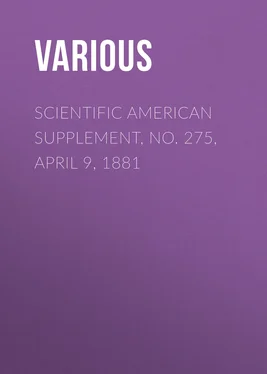Various - Scientific American Supplement, No. 275, April 9, 1881
Здесь есть возможность читать онлайн «Various - Scientific American Supplement, No. 275, April 9, 1881» — ознакомительный отрывок электронной книги совершенно бесплатно, а после прочтения отрывка купить полную версию. В некоторых случаях можно слушать аудио, скачать через торрент в формате fb2 и присутствует краткое содержание. Жанр: foreign_antique, periodic, foreign_edu, на английском языке. Описание произведения, (предисловие) а так же отзывы посетителей доступны на портале библиотеки ЛибКат.
- Название:Scientific American Supplement, No. 275, April 9, 1881
- Автор:
- Жанр:
- Год:неизвестен
- ISBN:нет данных
- Рейтинг книги:4 / 5. Голосов: 1
-
Избранное:Добавить в избранное
- Отзывы:
-
Ваша оценка:
- 80
- 1
- 2
- 3
- 4
- 5
Scientific American Supplement, No. 275, April 9, 1881: краткое содержание, описание и аннотация
Предлагаем к чтению аннотацию, описание, краткое содержание или предисловие (зависит от того, что написал сам автор книги «Scientific American Supplement, No. 275, April 9, 1881»). Если вы не нашли необходимую информацию о книге — напишите в комментариях, мы постараемся отыскать её.
Scientific American Supplement, No. 275, April 9, 1881 — читать онлайн ознакомительный отрывок
Ниже представлен текст книги, разбитый по страницам. Система сохранения места последней прочитанной страницы, позволяет с удобством читать онлайн бесплатно книгу «Scientific American Supplement, No. 275, April 9, 1881», без необходимости каждый раз заново искать на чём Вы остановились. Поставьте закладку, и сможете в любой момент перейти на страницу, на которой закончили чтение.
Интервал:
Закладка:
"The problem which ten years since confronted the millers of this city was how to obtain from the wheat which they had to grind a white, clear flour, and to so increase the yield as to leave some margin for profit. The first step in the solution of this problem was the invention by E. N. La Croix of the machine which has since been called the purifier, which removed the dirt and light impurities from the refuse middlings in the same manner that dust and chaff are removed from wheat by a fanning mill. The middlings thus purified were then reground, and the result was a much whiter and cleaner flour than it had been possible to obtain under the old process of low close grinding. This flour was called 'patent' or 'fancy,' and at once took a high position in the market. The first machine built by La Croix was immediately improved by George T. Smith, and has since then been the subject of numberless variations, changes, and improvements; and over the principles embodied in its construction there has been fought one of the longest and most bitter battles recorded in the annals of patent litigation in this country. The purifier is to-day the most important machine in use in the manufacture of flour in this country, and may with propriety be called the corner-stone of new process milling. The earliest experiments in its use in this country were made in what was then known as the 'big mill' in this city, owned by Washburn, Stephens & Co., and now known as the Washburn Mill B.
"The next step in the development of the new process, also originating in Minneapolis, was the abandonment of the old system of cracking the millstone, and substituting in its stead the use of smooth surfaces on the millstones, thus in a large measure doing away with the abrasion of the bran, and raising the quality of the flour produced at the first grinding. So far as we know, Mr. E. R. Stephens, a Minneapolis miller, then employed in the mill owned by Messrs. Pillsbury, Crocker & Fish, and now a member of the prominent milling firm of Freeman & Stephens, River Falls, Wisconsin, was the first to venture on this innovation. He also first practiced the widening of the furrows in the millstones and increasing their number, thus adding largely to the amount of middlings made at the first grinding, and raising the percentage of patent flour. He was warmly supported by Amasa K. Ostrander, since deceased, the founder and for a number of years the editor of the North-Western Miller , a trade newspaper. The new ideas were for a time vigorously combated by the millers, but their worth was so plain that they were soon adopted, not only in Minneapolis, but by progressive millers throughout the country. The truth was the 'new process' in its entirety, which may be summarized in four steps–first, grinding or, more properly, granulating the berry; second, bolting or separating the 'chop' or meal into first flour, middlings, and bran; third, purifying the middlings, fourth, regrinding and rebolting the middlings to produce the higher grade, or 'patent' flour. This higher grade flour drove the best winter wheat flours out of the Eastern markets, and placed milling in Minnesota upon a firm basis. The development of the 'new process' cannot be claimed by any one man. Hundreds of millers all over the country have contributed to its advance, but the millers of Minneapolis have always taken the lead.
"Within the past two or three years what may be distinctively called the 'new process' has, in the mills of Minneapolis and some few other leading mills in the country, been giving place to a new system, or rather, a refinement of the processes above described. This latest system is known to the trade as the 'gradual reduction' or high-grinding system, as the 'new process' is the medium high-grinding system, and the old way is the low or close grinding system. In using the gradual reduction in making flour the millstones are abandoned, except for finishing some of the inferior grades of flour, and the work is done by means of grooved and plain rollers, made of chilled iron or porcelain. In some cases disks of chilled iron, suitably furrowed, are used, and in others concave mills, consisting of a cylinder running against a concave plate. In Minneapolis the chilled iron rolls take the precedence of all other means.
"The system of gradual reduction is much more complicated than either of those which preceded it; but the results obtained are a marked advance over the 'new process.' The percentage of high-grade flour is increased, several grades of different degrees of excellence being produced, and the yield is also greater from a given quantity of wheat. The system consists in reducing the wheat to flour, not at one operation, as in the old system, nor in two grindings, as in the 'new process,' but in several successive reductions, four, five, or six, as the case may be. The wheat is first passed through a pair of corrugated chilled iron rollers, which merely split it open along the crease of the berry, liberating the dirt which lies in the crease so that it can be removed by bolting. A very small percentage of low-grade flour is also made in this reduction. After passing through what is technically called a 'scalping reel' to remove the dirt and flour, the broken wheat is passed through a second set of corrugated rollers, by which it is further broken up, and then passes through a second separating reel, which removes the flour and middlings. This operation is repeated successively until the flour portion of the berry is entirely removed from the bran, the necessary separation being made after each reduction. The middlings from the several reductions are passed through the purifiers, and, after being purified, are reduced to flour by successive reductions on smooth iron or porcelain rollers. In some cases, as stated above, iron disks and concave mills are substituted for the roller mill, but the operation is substantially the same. One of the principal objects sought to be attained by this high-grinding system is to avoid all abrasion of the bran, another is to take out the dirt in the crease of the berry at the beginning of the process, and still another to thoroughly free the bran from flour, so as to obtain as large a yield as possible. Incidental to the improved methods of milling, as now practiced in this country, is a marked improvement in the cleaning of the grain and preparing it for flouring. The earliest grain-cleaning machine was the 'smutter,' the office of which was to break the smut balls, and scour the outside of the bran to remove any adhering dust, the scouring machine being too harsh in its action, breaking the kernels of wheat, and so scratching and weakening the bran that it broke up readily in the grinding. The scouring process was therefore lessened, and was followed by brush machines, which brushed the dirt, loosened up and left by the scourer, from the berry. Other machines for removing the fuzzy and germ ends of the berry have also been introduced, and everything possible is done to free the grain from extraneous impurities before the process of reduction is commenced. In all the minor details of the mill there has been the same marked change, until the modern merchant mill of to-day no more resembles that of twenty-five years ago than does the modern cotton mill the old-fashioned distaff. The change has extended into the winter wheat sections, and no mill in the United States can hope to hold its place in the markets unless it is provided with the many improvements in machinery and processes which have resulted from the experiments begun in this city only ten years since, and which have made the name of Minneapolis and the products of her many mills famous throughout the world. The relative merits of the flour made by the new process and the old have been warmly discussed, but the general verdict of the great body of consumers is that the patent or new process flour is better in every way for bread making purposes, being clearer, whiter, more evenly granulated, and possessing more strength. Careful chemical analysis has confirmed this. As between winter and spring wheat flours made by the new process and gradual reduction systems, it maybe remarked that the former contain more starch and are whiter in color, while the latter, having more gluten, excel in strength. In milling all varieties of wheat, whether winter or spring, the new processes are in every way superior to the old, and, in aiding their inception and development, the millers of Minneapolis have conferred a lasting benefit on the country.
Читать дальшеИнтервал:
Закладка:
Похожие книги на «Scientific American Supplement, No. 275, April 9, 1881»
Представляем Вашему вниманию похожие книги на «Scientific American Supplement, No. 275, April 9, 1881» списком для выбора. Мы отобрали схожую по названию и смыслу литературу в надежде предоставить читателям больше вариантов отыскать новые, интересные, ещё непрочитанные произведения.
Обсуждение, отзывы о книге «Scientific American Supplement, No. 275, April 9, 1881» и просто собственные мнения читателей. Оставьте ваши комментарии, напишите, что Вы думаете о произведении, его смысле или главных героях. Укажите что конкретно понравилось, а что нет, и почему Вы так считаете.












